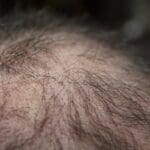Hair loss is a common concern for many individuals, and understanding the connection between hair loss and hormones can provide valuable insights into potential causes and treatment options. Hormonal imbalances can play a significant role in hair loss, and exploring this relationship is essential for those seeking to address this issue.
When our hormones are out of balance, it can disrupt the natural hair growth cycle, leading to hair loss. Hormones such as estrogen, testosterone, and thyroid hormones all have the potential to influence hair growth. Fluctuations in these hormones can contribute to hair loss in both men and women.
One hormone that is particularly influential in hair loss is dihydrotestosterone (DHT). DHT is a byproduct of testosterone and can bind to receptors in the hair follicles, causing them to shrink and eventually stop producing hair. This process, known as androgenetic alopecia or male/female pattern baldness, is a common form of hair loss influenced by hormonal imbalances.
Additionally, imbalances in thyroid hormones, such as thyroxine and triiodothyronine, can also impact hair growth. An underactive or overactive thyroid can disrupt the hair growth cycle and result in hair loss. Similarly, stress hormones like cortisol can disrupt the natural hair growth process, leading to hair loss in individuals experiencing chronic stress.
Fortunately, there are various treatment options available for hair loss caused by hormonal imbalances. Medications, lifestyle changes, and hormonal therapies can all be effective in addressing this issue. Consulting with a healthcare professional or dermatologist can help determine the most suitable treatment approach based on individual circumstances.
In conclusion, understanding the connection between hair loss and hormones is crucial for those seeking to address this concern. Hormonal imbalances can contribute to hair loss, and exploring potential treatment options can help individuals regain confidence and promote healthy hair growth.
Hormones and Hair Growth
Hormones play a significant role in hair growth, making it essential to understand their impact when exploring the connection between hair loss and hormonal imbalances. Hair growth is a complex process that involves various hormones working together to maintain a healthy hair cycle.
One hormone that plays a crucial role in hair growth is dihydrotestosterone (DHT). DHT is a byproduct of testosterone and is known to shrink hair follicles, leading to hair thinning and eventual hair loss. This hormone is particularly influential in androgenetic alopecia, commonly known as male or female pattern baldness. Understanding the role of DHT in hair loss can help identify potential treatment options.
Another hormone that affects hair growth is estrogen. Estrogen levels can influence the hair growth cycle, and fluctuations in estrogen levels can contribute to hair loss in both men and women. For example, during pregnancy, estrogen levels are high, leading to thicker and fuller hair. However, after childbirth, estrogen levels drop, causing hair shedding. Hormonal imbalances, such as polycystic ovary syndrome (PCOS), can also disrupt estrogen levels and contribute to hair loss.
Testosterone, typically associated with male characteristics, can also play a role in hair loss. When testosterone interacts with enzymes in the body, it can be converted into DHT, which, as mentioned earlier, can contribute to hair thinning and baldness. Understanding the interplay between testosterone and DHT is crucial in addressing hormonal hair loss.
The thyroid gland, located in the neck, produces hormones that regulate various bodily functions, including hair growth. Thyroid hormones, such as thyroxine and triiodothyronine, can influence hair growth. An imbalance in thyroid function, such as hypothyroidism or hyperthyroidism, can disrupt the hair growth cycle and lead to hair loss. It is important to address any underlying thyroid issues to promote healthy hair growth.
Stress hormones, such as cortisol, can also impact hair growth. Chronic stress can disrupt the hair growth cycle and contribute to hair loss. Managing stress levels through relaxation techniques, exercise, and a healthy lifestyle can help minimize the effects of stress hormones on hair health.
Understanding how hormones affect hair growth is crucial in addressing hair loss caused by hormonal imbalances. By identifying the specific hormone imbalances contributing to hair loss, targeted treatment options can be explored to promote healthy hair growth and restore confidence.
Androgenetic Alopecia: The Role of DHT
Androgenetic alopecia, also known as male or female pattern baldness, is a common type of hair loss that affects both men and women. This condition is influenced by the hormone dihydrotestosterone (DHT) and its impact on hair follicles.
DHT is a byproduct of testosterone, a hormone that is typically associated with male characteristics. In individuals with androgenetic alopecia, hair follicles become sensitive to DHT, which causes them to shrink and eventually stop producing new hair. This process is known as miniaturization.
As DHT levels increase, the hair follicles become smaller and produce thinner, shorter, and less pigmented hair. Eventually, the follicles may become dormant and stop producing hair altogether, leading to visible baldness in certain areas of the scalp.
It’s important to note that while DHT is primarily associated with male pattern baldness, it can also contribute to female pattern baldness. In women, hormonal imbalances, such as an increase in testosterone or a decrease in estrogen, can lead to an overproduction of DHT and subsequent hair loss.
To address androgenetic alopecia, various treatment options are available. Medications such as finasteride and minoxidil can help slow down hair loss and promote hair regrowth by reducing the effects of DHT on the hair follicles. These medications are typically used in combination to achieve optimal results.
In addition to medication, lifestyle changes can also play a role in managing androgenetic alopecia. Maintaining a healthy diet, managing stress levels, and avoiding excessive heat and styling damage can help support hair growth and minimize further hair loss.
In some cases, hormonal therapies may be recommended to regulate hormone levels and reduce the impact of DHT on the hair follicles. These therapies may include the use of birth control pills, anti-androgen medications, or hormone replacement therapy.
Overall, understanding the role of DHT in androgenetic alopecia is crucial in developing effective treatment strategies. By addressing hormonal imbalances and reducing the impact of DHT on the hair follicles, individuals experiencing pattern baldness can potentially slow down hair loss and promote healthier hair growth.
Estrogen and Hair Loss
Estrogen is a hormone that plays a crucial role in the growth and development of various bodily functions, including hair growth. It is commonly associated with female characteristics, but it is also present in males, although in smaller amounts. Fluctuations in estrogen levels can have a significant impact on the health and vitality of our hair.
When estrogen levels are in balance, it promotes hair growth by extending the growth phase of the hair follicles. This results in longer and thicker hair. However, imbalances in estrogen levels can disrupt the hair growth cycle, leading to hair loss.
In women, estrogen levels naturally fluctuate throughout their menstrual cycle. During certain phases, such as during ovulation or pregnancy, estrogen levels are higher, which can result in thicker and fuller hair. Conversely, during menopause or certain medical conditions, estrogen levels may decrease, leading to hair thinning and loss.
In men, estrogen plays a role in maintaining a healthy hair growth cycle. However, an imbalance between estrogen and testosterone levels can lead to hair loss. For example, an excess of estrogen relative to testosterone can inhibit the production of DHT, a hormone associated with hair loss. On the other hand, a decrease in estrogen levels can lead to an increase in DHT production, which can contribute to male pattern baldness.
It is important to note that while estrogen can influence hair growth, it is not the sole factor contributing to hair loss. Other factors, such as genetics, age, and overall health, also play a significant role. If you are experiencing hair loss or are concerned about your estrogen levels, it is recommended to consult with a healthcare professional who can provide guidance and explore potential treatment options.
Testosterone and Hair Loss
Testosterone, a hormone typically associated with male characteristics, can also play a role in hair loss when it interacts with enzymes in the body. While testosterone is essential for various bodily functions, including muscle development and sexual characteristics, an excess of this hormone can lead to hair loss.
When testosterone is converted into dihydrotestosterone (DHT) by the enzyme 5-alpha-reductase, it can bind to hair follicles and cause them to shrink. This process, known as miniaturization, weakens the hair follicles and eventually leads to hair loss.
It is important to note that both men and women have testosterone in their bodies, although men typically have higher levels. Women with hormonal imbalances, such as polycystic ovary syndrome (PCOS), may experience increased testosterone levels, which can contribute to hair loss.
While testosterone itself is not the sole cause of hair loss, its interaction with enzymes in the body can play a significant role. Understanding the connection between testosterone and hair loss is essential in exploring treatment options and addressing hormonal imbalances that may contribute to hair loss.
The Thyroid Connection
Thyroid hormones, such as thyroxine and triiodothyronine, play a crucial role in regulating various bodily functions, including hair growth. These hormones are responsible for maintaining the metabolism and energy levels in the body, which in turn affect the health of hair follicles.
When there is an imbalance in thyroid function, it can have a significant impact on hair growth. Both hypothyroidism (underactive thyroid) and hyperthyroidism (overactive thyroid) can contribute to hair loss.
In the case of hypothyroidism, the thyroid gland does not produce enough thyroid hormones, leading to a slowdown in the body’s metabolic processes. This can result in hair becoming thin, dry, and brittle, and eventually falling out. Additionally, the hair growth cycle may be disrupted, causing hair to take longer to grow back.
On the other hand, hyperthyroidism can also cause hair loss. An excess of thyroid hormones can accelerate the body’s metabolic processes, which can push hair follicles into the resting phase of the hair growth cycle prematurely. As a result, hair may shed more rapidly than usual.
It’s important to note that hair loss caused by thyroid imbalances is often diffuse, meaning it affects the entire scalp rather than specific areas. This distinguishes it from other types of hair loss, such as androgenetic alopecia, which typically manifests as pattern baldness.
If you suspect that a thyroid imbalance may be contributing to your hair loss, it is essential to consult with a healthcare professional. They can perform diagnostic tests to assess your thyroid function and recommend appropriate treatment options.
Treatment for thyroid-related hair loss typically involves addressing the underlying thyroid condition. This may include medication to regulate thyroid hormone levels, lifestyle modifications to support overall thyroid health, and dietary changes to ensure adequate intake of essential nutrients for hair growth.
In conclusion, the thyroid connection to hair loss highlights the importance of maintaining a healthy thyroid function for optimal hair growth. By addressing any imbalances and seeking appropriate treatment, individuals can improve the health and appearance of their hair.
Stress Hormones and Hair Loss
Stress hormones, such as cortisol, play a significant role in our body’s response to stress. While cortisol is essential for regulating various bodily functions, including metabolism and immune response, prolonged exposure to high levels of cortisol can have detrimental effects on our overall health, including our hair.
When we experience chronic stress, our body continuously releases cortisol, which can disrupt the normal hair growth cycle. Hair follicles go through different phases, including the growth phase (anagen), the transitional phase (catagen), and the resting phase (telogen). However, when cortisol levels are consistently elevated, it can push hair follicles into the resting phase prematurely, leading to increased hair shedding and thinning.
Moreover, stress hormones can also affect the production of other hormones involved in hair growth, such as estrogen and testosterone. Imbalances in these hormones can further contribute to hair loss. For example, high cortisol levels can interfere with estrogen production, leading to a decrease in hair density and quality.
It’s important to note that not everyone will experience hair loss due to stress hormones, as individual susceptibility varies. However, for those who are genetically predisposed to hair loss or already experiencing hair thinning, chronic stress can exacerbate the condition.
Managing stress levels is crucial in maintaining healthy hair. Incorporating stress-reducing activities such as exercise, meditation, and deep breathing exercises into your daily routine can help regulate cortisol levels and promote a healthier hair growth cycle. Additionally, seeking support from friends, family, or a therapist can also be beneficial in managing chronic stress.
In conclusion, stress hormones, particularly cortisol, can disrupt the hair growth cycle and contribute to hair loss in individuals experiencing chronic stress. Taking steps to manage stress levels and prioritize self-care can help mitigate the impact of stress on hair health.
Treatment Options for Hormonal Hair Loss
Treatment Options for Hormonal Hair Loss
When it comes to addressing hair loss caused by hormonal imbalances, there are several treatment options available. These options range from medications to lifestyle changes and even hormonal therapies. Let’s explore each of these options in detail:
- Medications: There are several medications that can help treat hormonal hair loss. One commonly prescribed medication is finasteride, which works by blocking the production of DHT, the hormone responsible for androgenetic alopecia. Another medication is minoxidil, which is a topical solution that stimulates hair growth. It is important to consult with a healthcare professional before starting any medication to ensure it is suitable for your specific condition.
- Lifestyle Changes: Making certain lifestyle changes can also help address hormonal hair loss. Eating a balanced diet rich in vitamins and minerals, particularly those that promote hair health, can make a significant difference. Additionally, reducing stress levels through activities like exercise, meditation, or engaging in hobbies can help reduce the impact of stress hormones on hair growth.
- Hormonal Therapies: Hormonal therapies can be used to regulate hormone levels and address hair loss. For example, hormone replacement therapy (HRT) may be recommended for individuals experiencing hair loss due to menopause or hormonal imbalances. HRT involves the use of medications that supplement or replace hormones in the body. It is important to consult with a healthcare professional to determine if hormonal therapies are suitable for your specific situation.
It is worth noting that the effectiveness of these treatment options may vary from person to person. It is important to consult with a healthcare professional or a specialist in hair loss to determine the most suitable treatment plan for your specific needs. They can assess your hormone levels, evaluate your overall health, and recommend the most appropriate course of action.
Frequently Asked Questions
- 1. Can hormonal imbalances cause hair loss?
Yes, hormonal imbalances can contribute to hair loss. Fluctuations in hormone levels, such as estrogen and testosterone, can disrupt the hair growth cycle and lead to hair loss.
- 2. What is androgenetic alopecia?
Androgenetic alopecia, also known as male or female pattern baldness, is a common form of hair loss influenced by the hormone dihydrotestosterone (DHT). DHT can shrink hair follicles, leading to thinner and shorter hair.
- 3. How do estrogen levels affect hair growth?
Estrogen levels play a role in hair growth. Fluctuations in estrogen, such as during pregnancy or menopause, can impact the hair growth cycle and result in hair loss. Maintaining balanced estrogen levels is important for healthy hair.
- 4. Can testosterone contribute to hair loss?
Yes, testosterone can contribute to hair loss when it interacts with enzymes in the body. Testosterone can be converted into DHT, which can negatively affect hair follicles and lead to hair thinning or baldness.
- 5. Is there a connection between thyroid function and hair loss?
Thyroid hormones, such as thyroxine and triiodothyronine, can influence hair growth. An imbalance in thyroid function, such as hypothyroidism or hyperthyroidism, can disrupt the hair growth cycle and result in hair loss.
- 6. How does chronic stress contribute to hair loss?
Chronic stress can impact hormone levels, including cortisol, which is a stress hormone. Elevated cortisol levels can disrupt the hair growth cycle and lead to hair loss. Managing stress through relaxation techniques and self-care can help mitigate this effect.
- 7. What treatment options are available for hormonal hair loss?
There are various treatment options for hormonal hair loss. These include medications such as minoxidil or finasteride, lifestyle changes like a balanced diet and regular exercise, and hormonal therapies that aim to regulate hormone levels and promote hair growth.








Leave a Reply